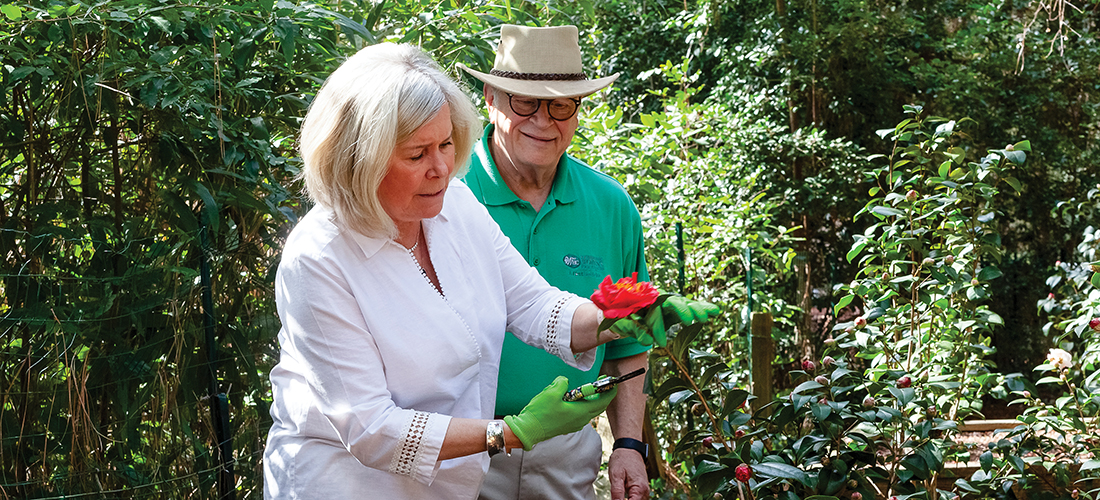
A free-spirited and romantic escape
By Claudia Watson • Photographs by John Gessner
The light snow clinging to the winter-into-spring camellias prompted her early morning call last March. “Oh, you must come and see these camellias before the snow is gone,” said an enthusiastic June Buchele. “The blooms look stunning against the clear blue sky.”
The first signs of spring are the sweetest in Barry and June Buchele’s garden. A warming sun peaks through the treetops as we enjoy the spectacle of hundreds of vibrant large camellia blooms dusted with snow. It’s a stunning prelude to an intoxicating buffet of things that start small. Nearby, winter snowdrops and hellebores peek out from under layers of leaf mulch, and the bright yellow stamens of crocus shout, “Spring is here!”
“Oh gosh, it’s my favorite time of year,” says June, an accredited American Camellia Society (ACS) judge and an energetic N.C. Extension master gardener volunteer. “I can’t wait for the daffodils to bloom,” pointing to the long green stalks reaching for the sun.
The Bucheles’ garden is a free-spirited and romantic escape with only a touch of discipline for Mother Nature. Just steps away from busy Beulah Hill Road, the sound of traffic falls silent. Their property in Old Town Pinehurst is obscured behind a thickly planted border of big old-growth trees and shrubs. “No one knows it’s even back here,” says Barry, who’s quick to share the history.
In 1916, James Wells Barber, an international shipping magnate, purchased the 1.24-acre property. He commissioned Leonard Tufts’ brother-in-law, architect Lyman Sise, to build the home for him and his wife, Kate. According to historical documents, they named the “two-story, weather-boarded, Tuscan-columned cottage, with two large stone chimneys” Cedarcrest.
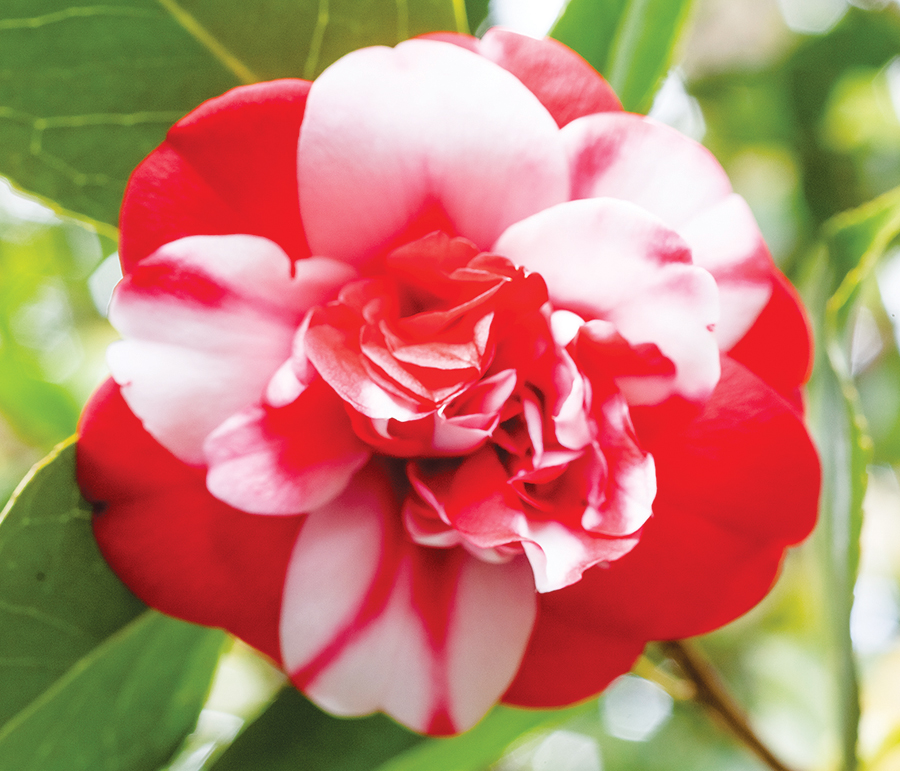
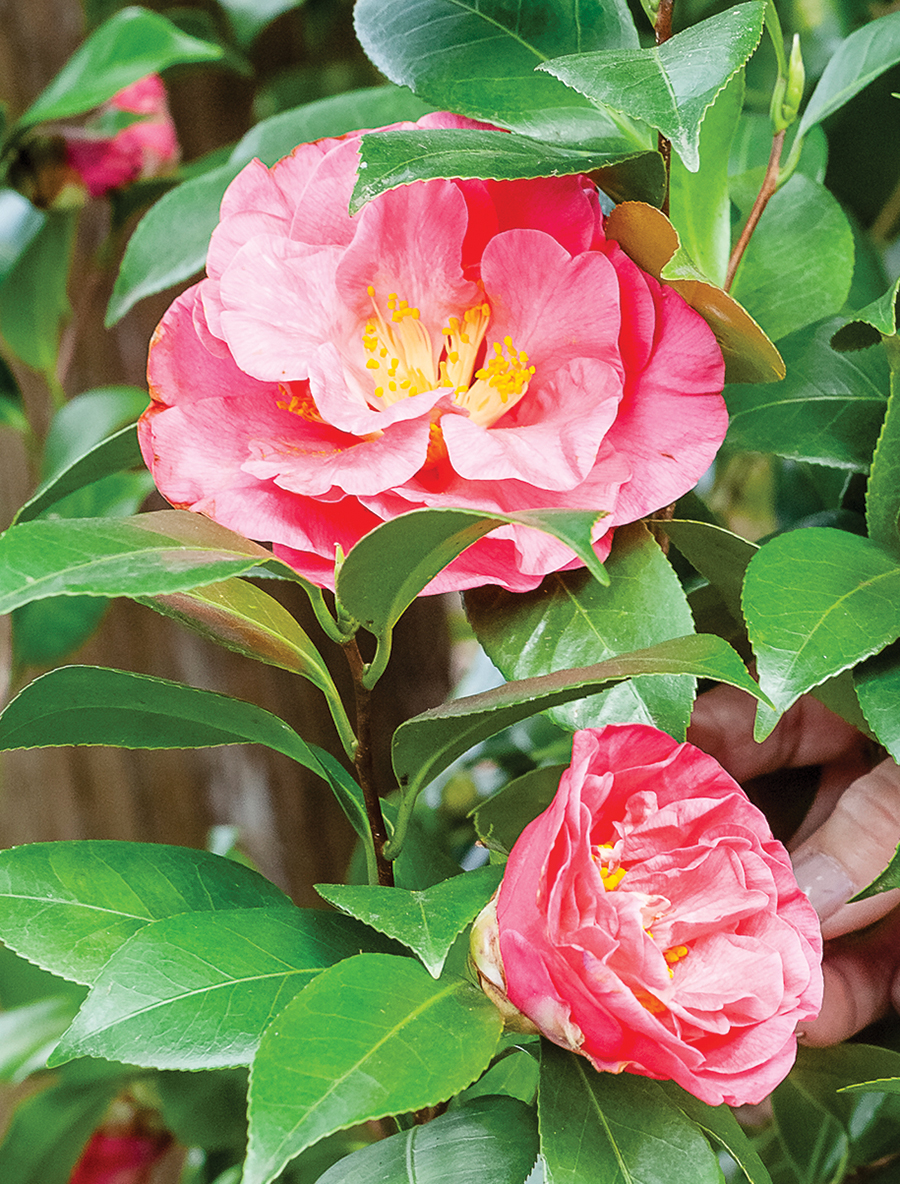
Barber took a large portion of the property and built the “Lilliputian,” the country’s first nine-hole miniature golf course. Before they moved in, they commissioned Sise to construct a grander Federal Revival mansion across the street. Known as Thistle Dhu, it was the location of the country’s first 18-hole pitch-and-putt miniature golf course. Cedarcrest contributes to Pinehurst’s designation as a National Historic Landmark.
Barry and his late wife, Sarah, purchased Cedarcrest in 1987. An ob/gyn, he founded the Southern Pines Women’s Health Center in 1981. It was a solo practice for nearly three years.
“I was working 80 to 100 hours a week and couldn’t leave Moore County for nearly three years since I was on 24-hour call,” he recalls. “When I had time off, I was usually sleeping. Gardening was not on the top of my list, though I always had my tomato and pepper plants.”
After Sarah’s untimely death in 2012, Barry admits it was a rough time, recalling the empty house, the untended garden, and the loneliness. He met June through an online dating site, and they married 16 months later.
“When we talked about getting married, June said to me, ‘If we get married, I’d like to bring some color to the house and garden,’” he recalls. “I told her, ‘There is no if,’ and I promised her she could. Her love of flowers adds so much to our home and life.”
Now semi-retired, Barry and his bride of seven years share the love of the land and a passion for creating a beautiful space, though he admits he didn’t know what was outside his doors until he met and married June.
“June woke one morning and looked out the window,” he says. “She turned to me, asking, ‘Barry, do you know how many camellias you have out there?’”
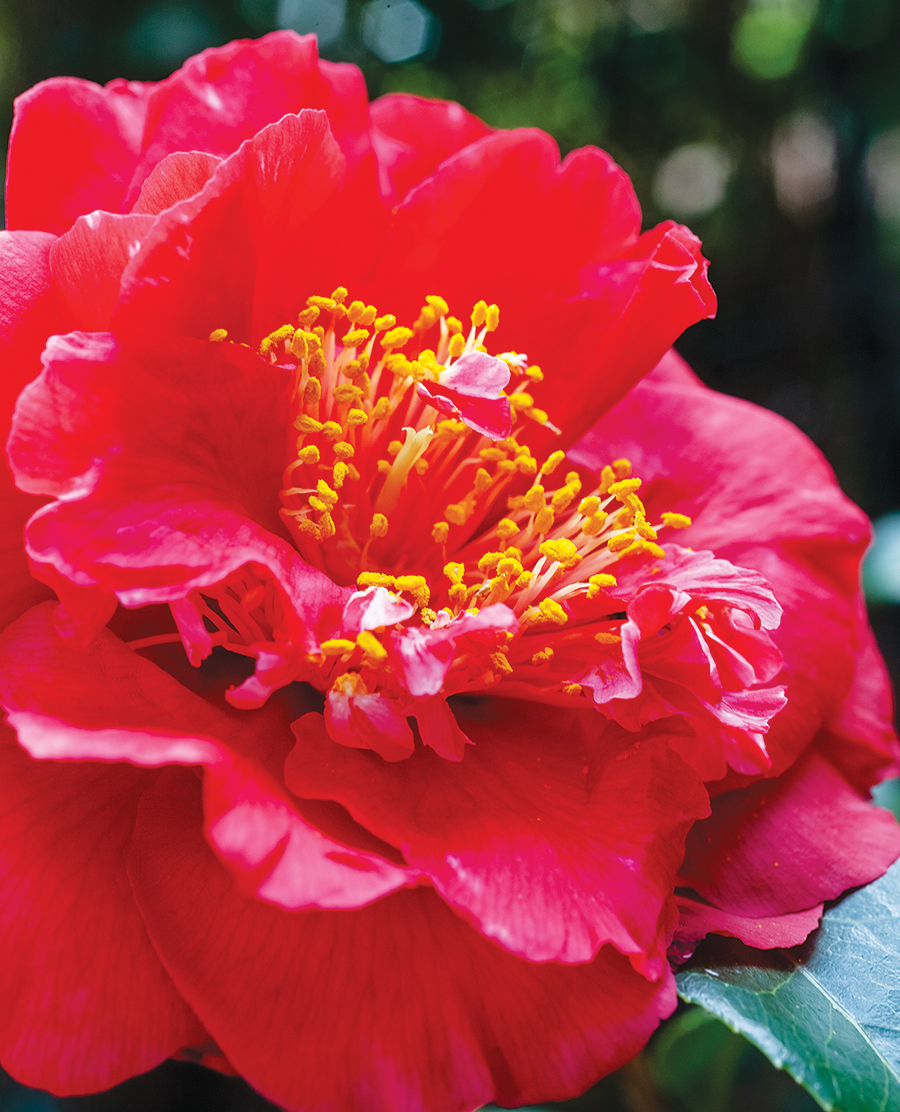
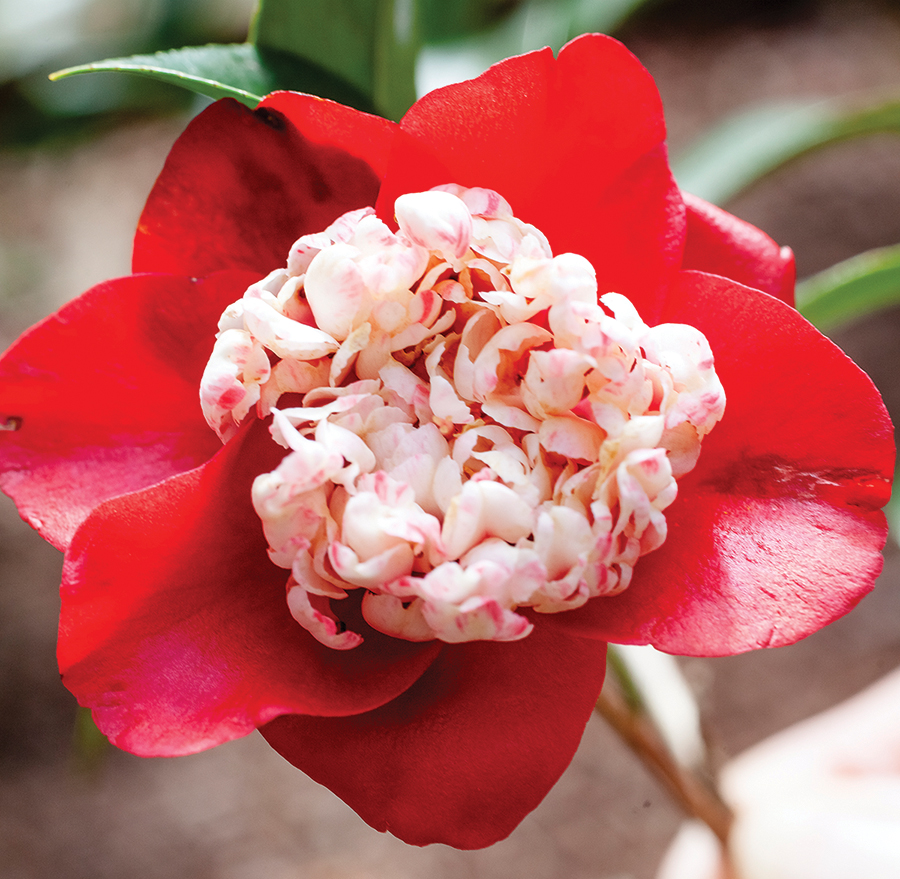
He had no idea, so June pulled on her coat and boots and took the better part of the morning to count. She returned to tell him, “There are over 100 on the property.” His astonished reply was, “Huh?”
The Bucheles credit the previous owner for planting the garden’s bones with a collection of camellias (Camellia japonica and Camellia sasanqua), hollies and azaleas growing under a canopy of longleaf pines and live oaks, giving it subtle Southern charm. There is a comforting wildness to the place, with an abundance of deciduous trees and evergreen shrubs stretching to the sunlight, providing a secure habitat for a herd of deer, rabbits, an occasional fox and turtle, and numerous birds. When flocks of chattering cedar waxwings arrive in the winter to feed on the holly berries, June hangs out the upstairs windows to watch and photograph them.
With a degree in education from the University of North Carolina-Chapel Hill, she taught elementary and intermediate school science, English and Spanish. She also studied botany with Clifford Parks, a world-renowned camellia expert. That experience developed her knowledge of botany, propagation, and the advantages of good soil fertility. Still, she confesses she didn’t truly appreciate the beauty of camellias until she moved to Pinehurst.
June was raised in Charlotte, where the dark red clay there was not favorable for camellias. Instead, her father and grandfather propagated and grew boxwoods, her first love. Her mother enjoyed flowers and became a talented floral designer who won ikebana (the Japanese art of flower arranging) competitions. “Gardening is in my Southern heritage,” she says.
The Bucheles claim 80-90 varieties of camellias among the 100-plus they count today, providing a lush backdrop during the non-blooming months for other shrubs and continuously changing the landscape.
Despite the abundance of the broadleaved evergreens, last winter they built several raised beds for the exclusive purpose of growing new camellias for exhibitions.
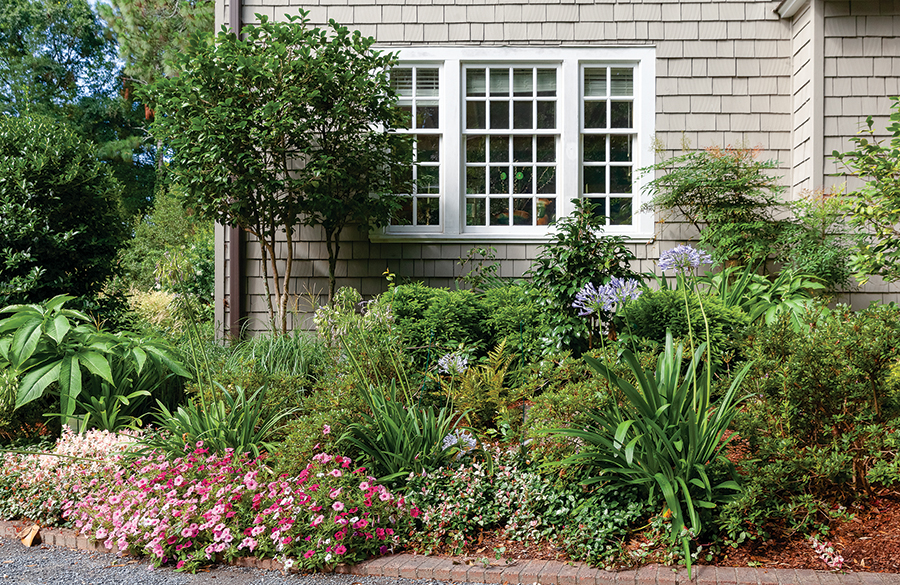
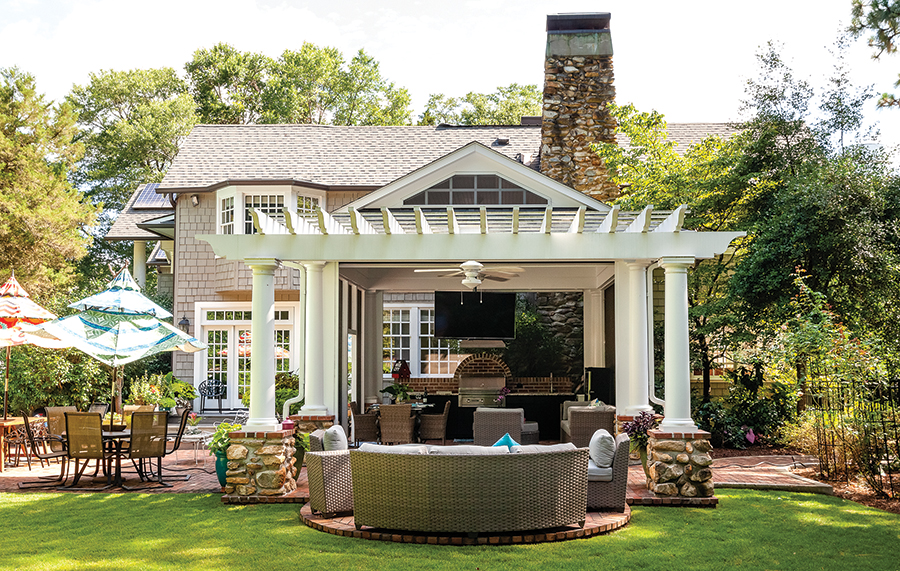
“We planted 44 new, rare or unusual camellia japonica varieties,” June explains. “I keep them small and tidy — one plant, one bloom. You enter to win with a spectacular bloom.” She’s won awards two of the past three years.
The new camellia beds receive special care and are situated in six locations to determine the best one for growing each variety. Camellias thrive in the region’s acidic soil. Most prefer understory shade or part shade, but some have adapted to full sun. They grow best in soils high in organic matter, and the Bucheles fill the beds with a blend of Brooks eggshell compost and homemade compost.
Barry, now a seasoned gardener, is often up to his ankles in the compost, checking and turning it as it slowly develops under an ancient live oak. “This is fluffy, rich and ready to go into the beds,” he says while scooping a forkful into the wheelbarrow.
Late winter, they usually pack up their van for the busy camellia judging schedule, attending shows up and down the East Coast. But this year, the format requires photos of entries sent by email and then judged on Zoom. “We’re not sure how this is going to work,” says a dubious June, who’s volunteered to be a judge at the first ACS competition this year, in Fayetteville, via Zoom.
In normal times, Barry volunteers as a show “runner” — carefully delivering the fragile single blooms perched in small cups to the head table for further judging. “Dropping or damaging a bloom is not a good thing,” he says, noting an unblemished track record.
“We’ve learned so much,” adds June. “The people I judge with are very passionate about growing and showing camellias and sharing knowledge. We’ve all become good friends, which makes it enjoyable for both of us. Plus, we get to see a lot of beautiful places.”
The division of labor in their garden is simple, explains Barry. “My main thought about gardening is, ‘What can I eat?’ June is more of, ‘What flowers can I cut and bring into the house?’”
Raised in Texas, Barry’s father, also a doctor, would occasionally take Barry and his brother to their grandfather’s farm in southern Kansas. “Gardening and farming were in our blood,” he explains. “But Dad hated farming and didn’t want to do it. He’d take us there and work our butts off. He wanted us to gain an appreciation for a farmer’s hard work and to understand the importance of staying in school.
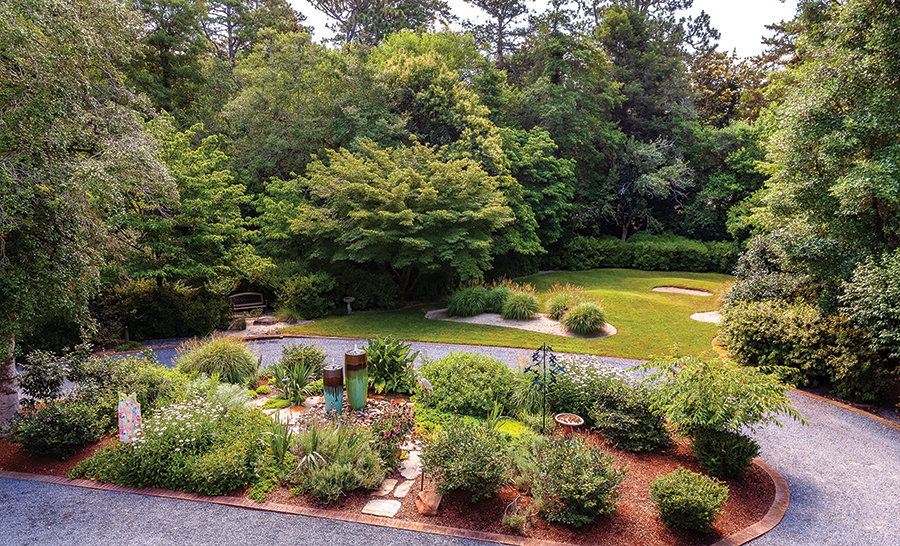
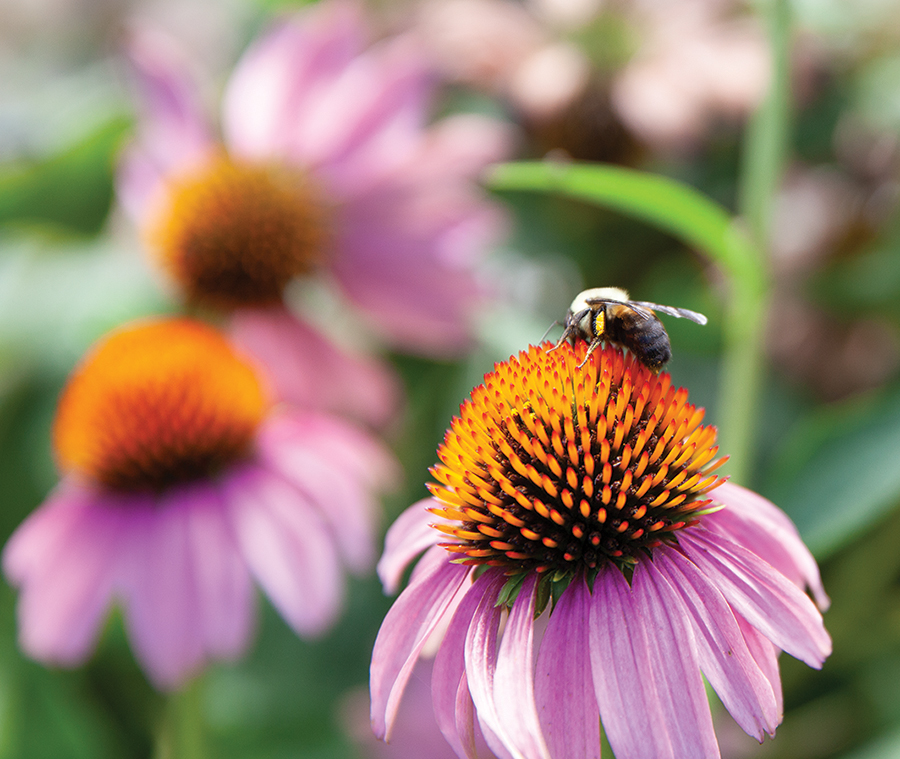
“So, now I’m in charge of the compost and varmint control,” he says, laughing as he readjusts his soil-smudged garden hat. Countermeasures used to keep the rabbits and birds out of the vegetable garden include colorful fake snakes hanging from the tomato cages and a chicken-wire fence. Still, he admits, the voles get the best of them, “They ate the entire shade garden last year.”
In addition to the busy camellia season, spring brings a multitude of requisite heavy maintenance and weekly garden chores, which they’ve handed off to Cooley and Co. Landscape. But they stay connected with the essence of Mother Nature.
June plucks wilted foliage and prowls for weeds as she walks. She stops abruptly, reaching for an antique climbing rose. “It’s a Pierre de Ronsard,” the name lilting off her tongue. “The color changes from a soft pink to a deep rose,” she says, inhaling its heavenly fragrance and passing it along for a sniff.
Continuing down the walk, June points out areas for ambitious cleanup and planting projects. “I move plants a lot. If they are not doing well, I dig ’em up and replant. That’s the fun thing about gardening — it’s all an experiment.” She laughs and tugs at a prickly-ivy greenbrier (Smilax rotundifolia) branch that’s entangling her beloved peonies.
She discloses her plans for the azaleas, which she despises. “They bloom once and are done. Then they look leggy and sickly, not at all like camellias with their beautiful thick foliage.” So, last winter she took matters into her own hands and did extensive renovation pruning. “They were this high,” she says, motioning to her shoulders. “Now, they’re a foot high. But they’ll grow out and be pretty again.”
A recent makeover of the front included replacing a forlorn wildflower garden with a chipping green. Carved out of lush Xeon zoysia, it’s surrounded by blossoming redbuds, pink and white dogwoods, azaleas, forsythia, and graceful bridal wreath spirea. A dramatic Kousa dogwood (Cornus kousa) with its profusion of large, white flower bracts and red berries provides an attractive and long-lasting display throughout spring and summer.
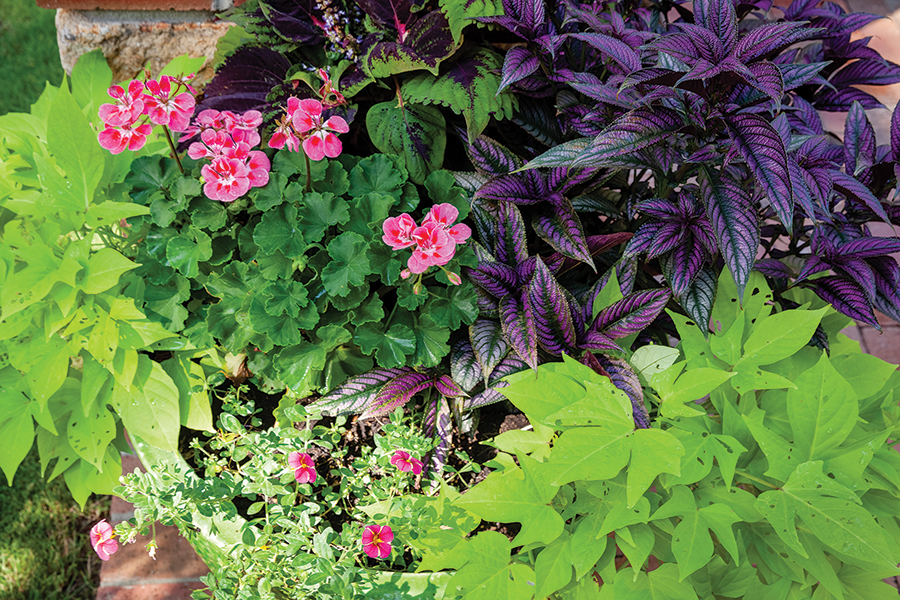
Nearby, a large oval garden graces the house’s entrance. It’s an exuberant mix of daffodil bulbs, hardy camellias, English lavender, mixed ranunculus, and clumps of Shasta daisies and gladiolas. Pollinator-friendly perennials include cheerful Black-eyed Susan (Rudbeckia hirta L.), salvia, coneflowers, and a false wild yellow indigo (Baptisia tinctoria). The spreading habit of several Lantana ‘Chapel Hill’ plants act as groundcover to brighten the area. Free-flowering, ivory-colored calla lilies (Zantedeschia ‘Intimate Ivory’) create drama all season long.
Two towering pottery fountains anchor the bed while a long-legged, sharp-beaked stork poses quietly nearby. “Storks are rumored to bring babies, but Barry’s the one that does that,” says June of the counterfeit bird. “He’s delivered over 11,000 babies, so I had to put one out there in his honor.”
But it’s the back of the property that’s their private oasis. When the old brick patio began to heave from the pressure of nearby tree roots, they asked builder Ken Bonville to design and create an outdoor living space. “It’s functional with an outdoor kitchen, and it’s as welcoming and entertaining as a family room,” notes Barry.
“We made sure we had it screened so we’d enjoy it without being eaten up by the bugs,” he says of the covered space with patio-to-ceiling rolldown screens. The patio extends outside the covered structure to include a cozy fire pit. Twin big-screen TVs, mounted back-to-back, allow sports fans to enjoy the action inside or from the fire pit and pool area.
June enjoys dressing up the outdoor room with her artfully arranged freshly cut flowers. “To me, flowers make a house a home,” she says. “With this area and our pool, it fits how we live. We spend a lot of time together here. It’s relaxing and keeps us connected to the beauty and serenity of our garden.”
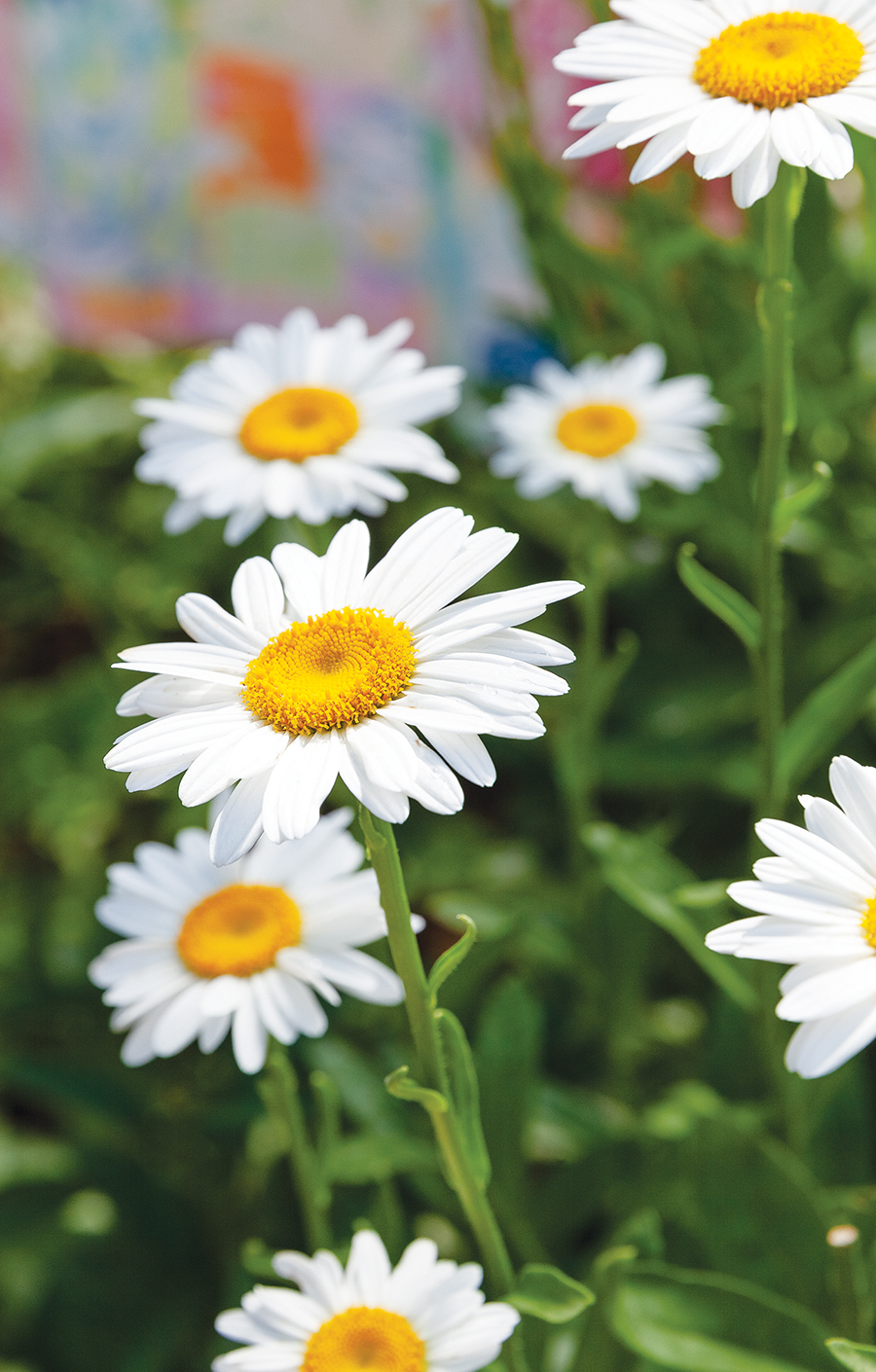
Native Bronze Dixie Sweet scuppernong grapes wrap along a trellis in a sunny portion of the backyard. “This variety is wonderful — big, sweet, and very juicy. Since June’s turned over the grapes to me, I handle the pruning, and when we get good grapes, I claim success,” Barry says.
Bordering the vineyard is June’s deer-resistant peony bed, which started with one selection from Tony Avent’s Plant Delights Nursery, a favorite for plant hunters. That peony (Paeonia ‘Scarlet O’Hara’) led to yearly additions, and the bed now has over 30 peonies that bloom in time for Mother’s Day. Closer to the pool, there’s a collection of tropical-looking hardy ginger plants, including an exotic Hedychium coronarium with a fragrance similar to jasmine. Elephant ears (Colocasia), daylilies (Hemerocallis), and specimens of Amorphophallus titanium, known as the ‘Corpse flower,’ and Hippeastrum ‘Voodoo,’ add mystery.
Working side-by-side in the garden, the couple divide and conquer, with each taking on different tasks. Everything doesn’t always go as planned, but they take time to enjoy its beauty and peacefulness.
“A few years ago, I built the simple slate path that threads through the back of the property. It’s bordered by dozens of azaleas and camellias and it’s the most tranquil place when they’re blooming. I get lost in the flowers,” reflects Barry. “If it weren’t for June, there wouldn’t be a garden.”
Their garden — a changeable, renewable paradise that stirs the senses and spirits, igniting a love of life. PS
Claudia Watson is a frequent contributor to PineStraw and The Pilot and finds the joy in each day, often in a garden.





